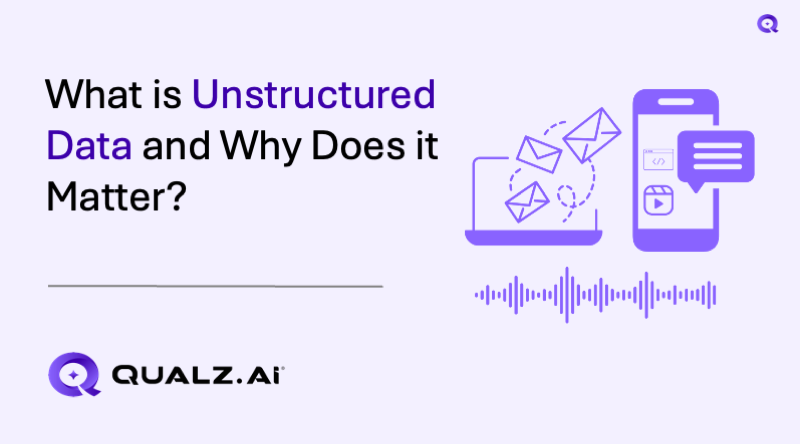If you’ve ever stared at a folder full of interview transcripts and open-ended surveys, unsure where to begin—you’re not alone. For academic researchers, unstructured data is everywhere, yet it’s one of the most difficult assets to use effectively.
It’s raw, messy, and overwhelming. But it’s also packed with meaning—if you know how to unpack it.
Topics Covered
ToggleIn this post, we’ll break down what unstructured data is and why it’s essential for generating deeper, more meaningful research outcomes.
What Is Unstructured Data?
Unstructured data is information that doesn’t follow a specific format or data model. Unlike neatly organized spreadsheets or survey scores, unstructured data lacks consistent labels or structure. It can’t be easily sorted, analyzed, or quantified using traditional tools.
Here’s a breakdown of what makes unstructured data unique:
1. Textual
Most unstructured data in academia is text-heavy: transcripts, reflections, discussion board posts, open survey fields, journal entries, written comments, and more. These texts are expressive and complex, rich in context and emotion.
2. Multimodal
Unstructured data extends beyond text. Video and audio recordings from lectures, workshops, or interviews fall into this category. So do screenshots, handwritten notes, or diagrams created during fieldwork. This multimodal quality expands what can be analyzed—and how.
3. Naturally Occurring
Unstructured data often comes from environments where responses aren’t “forced” into categories. It might emerge during a casual conversation, a course forum, or an unsolicited email. This makes it authentic, spontaneous, and reflective of real thoughts and emotions.
4. Non-Standardized and Free-Form
There’s no single format or protocol. Two student reflections can look entirely different. One may write three paragraphs; another might provide bullet points. Their value isn’t in uniformity—but in individuality and richness.
5. Hard to Quantify, Rich to Interpret
While structured data is easily measured, unstructured data needs to be understood. It’s interpretive. It invites meaning-making. This makes it central to qualitative inquiry, narrative analysis, and other inductive research approaches.
Common Types of Unstructured Data
Unstructured data shows up across nearly every academic discipline. Whether you’re conducting research in education, public health, anthropology, psychology, or the humanities, you’re likely gathering this type of data already—often without labeling it as such.
Here are the most common sources:
1. Interview and Focus Group Transcripts
Used in qualitative studies to explore behavior, experiences, or attitudes in depth. Transcripts provide long-form narratives full of detail.
2. Open-Ended Survey Responses
Whether part of a paper survey or an online form, these allow respondents to answer in their own words, giving room for rich, personalized feedback.
3. Student Reflections and Feedback Forms
Educational research often includes written reflections or end-of-semester feedback with narrative content that reveals student experiences.
4. Email Correspondence
Conversations between researchers and participants or among academic collaborators often contain valuable commentary, ideas, and concerns.
5. Discussion Boards and Forums
Online course platforms, research study sites, or participant communities can offer streams of text-based content worth analyzing.
6. Social Media Comments and Posts
For studies involving public opinion, media, or discourse analysis, social channels like Twitter, Reddit, or Facebook become rich sources of unstructured input.
7. Audio and Video Recordings
Often used in ethnographic, field-based, or classroom observation research. These recordings are full of subtle meaning—tone, pacing, emotion—that is rarely captured in structured data formats.
Why Does Unstructured Data Matter?
Unstructured data is not just “extra” information. It’s the heart of qualitative inquiry. While structured data can tell us what’s happening—test scores declining, program satisfaction decreasing, or enrollment patterns shifting—it rarely explains why. Unstructured data fills that gap.
Here’s why it matters:
1. It Answers the “Why” Behind the “What”
Structured data might tell you what happened—course satisfaction dropped, or a program failed to meet its objectives. But it’s unstructured data that tells you why. What were participants feeling? What barriers did they face? What suggestions did they offer? These answers are often hidden in open-ended responses, reflective journals, interview transcripts, and personal anecdotes.
2. It Captures Voice and Perspective
Especially in research involving marginalized or underrepresented groups, unstructured data gives participants a platform to speak in their own words—without being constrained by preset answer choices. This makes your research more inclusive, ethical, and meaningful.
3. It Supports Richer Theoretical Development
Grounded theory, ethnography, case study methods, and phenomenological research all rely on the nuanced detail found in unstructured data. Themes, concepts, and patterns emerge organically, making theories more authentic and reflective of lived experience.
4. It Strengthens Triangulation and Mixed Methods Studies
In mixed methods designs, unstructured data adds a qualitative dimension that validates or challenges quantitative findings. It brings depth and context to numeric trends, offering a more complete understanding of the subject.
5. It Humanizes Research
Unstructured data reminds us that research isn’t just about numbers. It’s about people. Their thoughts. Their stories. Their environments. It’s this type of data that allows researchers to advocate for change, influence policy, or recommend program adjustments based on lived realities—not just raw figures.
6. It Drives Innovation and Insight
Breakthroughs often come from what wasn’t asked—but was said anyway. Unstructured data allows unexpected themes to emerge—ones that the researcher may not have thought to investigate. These serendipitous insights can lead to fresh research questions, new methods, or novel interventions.
From Unstructured to Insightful
Whether you’re gathering field notes, collecting open-ended surveys, or reviewing student feedback, you’re already working with unstructured data. The next step is to recognize its value—not as a messy byproduct of research but as a primary source of insight. It holds the emotion, story, and voice behind the data. It invites us to ask better questions and listen more deeply. When handled with care and clarity, unstructured data becomes the foundation for richer understanding, better outcomes, and more human-centered research.
